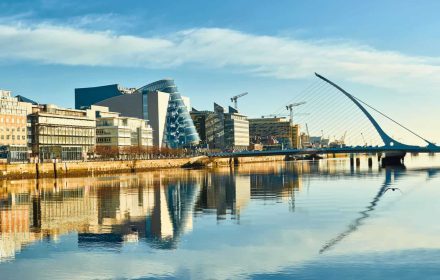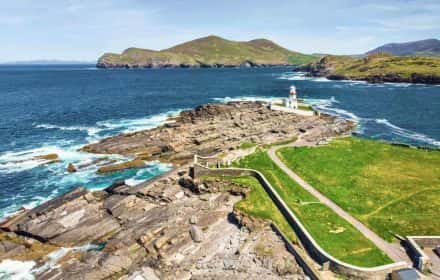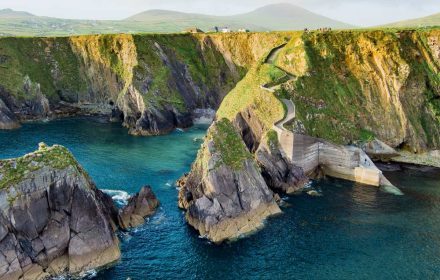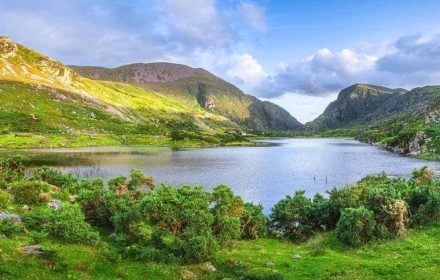This site uses affiliate links, meaning that if you make a purchase through our links, we may earn an affiliate commission.
Hello there, Dublin-bound adventurers! Ready to dive into 48 hours of Irish charm? Dublin may be compact, but it’s bursting with character and culture, making every moment count in this city.
Let’s keep it simple yet sensational—explore iconic landmarks, savor local flavors, and soak up the welcoming atmosphere. From historic sites like Dublin Castle to cozy pubs, get ready for an adventure through the heart of Dublin. Let’s make these 2 days in Dublin unforgettable!
- 1. Map of 2 Days in Dublin with 15 Best Stops
- 2. DAY 1
-
- 2.1. The Famine Memorial
- 2.2. EPIC The Irish Emigration Museum
- 2.3. The Jeanie Johnston Tall Ship & Famine Experience
- 2.4. Trinity College and the Long Room
- 2.5. The National Gallery of Ireland
- 2.6. The Little Museum of Dublin
- 2.7. Stephen's Green Shopping Centre
- 2.8. The Molly Malone Statue
- 2.9. The Ha'penny Bridge
- 2.10. Temple Bar District
- 3. DAY 2
-
- 3.1. Dublin Castle
- 3.2. Christ Church Cathedral
- 3.3. Dublinia
- 3.4. Kilmainham Goal
- 3.5. Guinness Storehouse
- 4. Final Intrepid Scout's Tips for 2 Days in Dublin
Map of 2 Days in Dublin with 15 Best Stops
2 Day in Dublin / Map with 15 Top Attractions
DAY 1
- The Famine Memorial
- EPIC The Irish Emigration Museum
- The Jeanie Johnston Tall Ship & Famine Experience
- Trinity College and the Long Room
- The National Gallery of Ireland
- The Little Museum of Dublin
- Stephen’s Green Shopping Centre
- The Molly Malone Statue
- The Ha’penny Bridge
- Temple Bar District
The Famine Memorial
Start your two-day journey through Dublin at the Famine Memorial, which is a solemn tribute to one of the darkest chapters in Irish history. It is situated along the banks of the River Liffey in Dublin’s Docklands.
This poignant monument was designed by renowned artist Rowan Gillespie and unveiled in 1997.
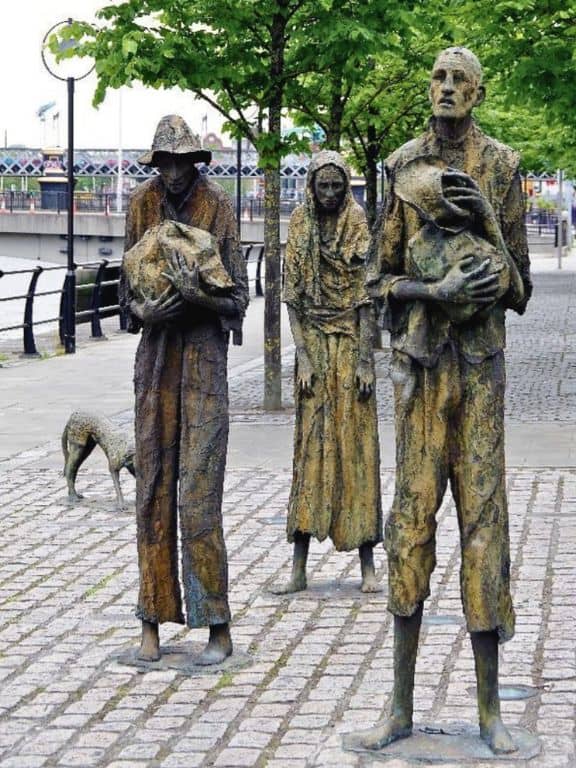
The Famine Memorial in Dublin
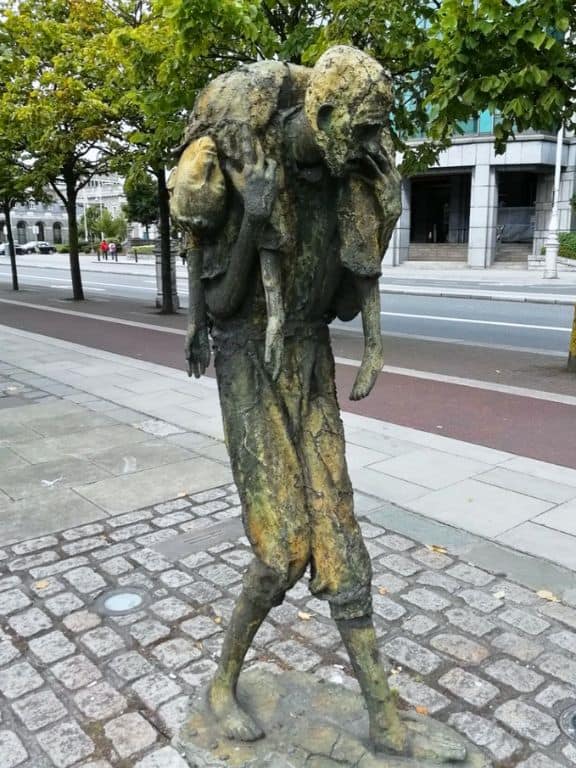
The Famine Memorial in Dublin
It comprises six life-size bronze sculptures depicting the Irish people’s harrowing experiences during the 19th-century Irish Famine, commonly known as the Great Famine or the Great Hunger.
Each figure portrays emaciated individuals, dressed in tattered clothing and clinging to their few belongings, as they walk with stoic determination toward ships destined for North America, seeking escape from the famine’s devastation.
The Famine Memorial serves as a powerful testament to the devastating impact of the Irish Famine, commemorating the estimated one million lives lost and millions more displaced or forced to emigrate due to starvation, disease, and poverty.
EPIC The Irish Emigration Museum
Your next stop is EPIC The Irish Emigration Museum.
The museum delves into the history of the Irish diaspora and their migration to various countries.
Designed by the London-based firm Event Communications, it has been acclaimed as “Europe’s Leading Tourist Attraction” at the 2019, 2020, and 2021 World Travel Awards.
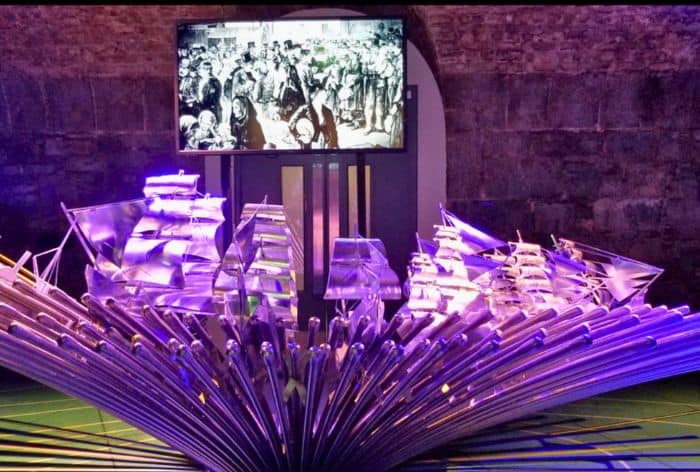
EPIC The Irish Emigration Museum / 2 Days in Dublin
The museum’s founder, Neville Isdell, former chairman and CEO of The Coca-Cola Company established EPIC as a privately owned institution.
Officially opened by former President of Ireland Mary Robinson in May 2016, EPIC comprises twenty galleries, each with its thematic focus. These galleries are categorized into Migration, Motivation, Influence, and Diaspora Today.
For instance, the “Migration” section traces migration patterns from Ireland since 500 AD, covering religious missionary work, the Irish famine, social persecution, criminal transportation, and Irish involvement in foreign conflicts.
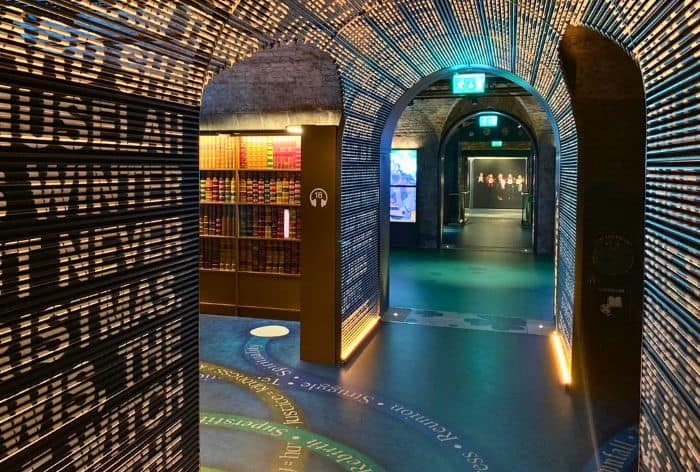
EPIC The Irish Emigration Museum / 2 Days in Dublin
Video testimonies from six Irish emigrants offer personal insights into these historical events.
EPIC’s exhibitions highlight the profound global impact of Irish emigration. From politics to sports, the museum showcases the diverse contributions of Irish immigrants.
I can’t recommend enough that you visit EPIC The Irish Emigration Museum. For me, it was a profound experience not only going through its huge repository of historical documents but also I felt inspired by hope and pride in future generations.
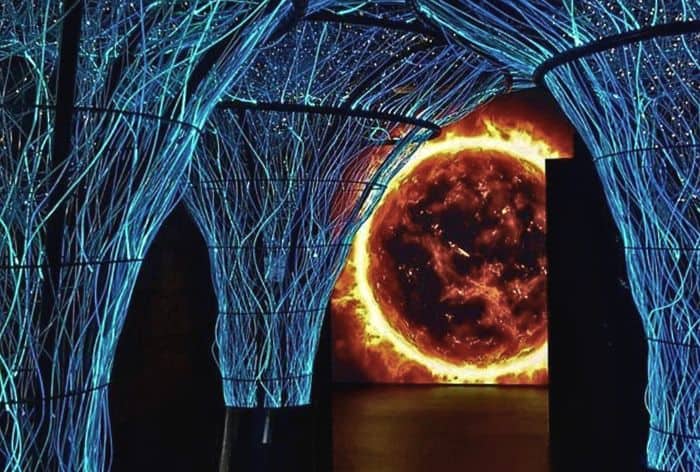
EPIC The Irish Emigration Museum / 2 Days in Dublin
The Jeanie Johnston Tall Ship & Famine Experience
Right next to the museum, you will find a replica of a 19th-century tall ship that offers The Jeanie Johnston Tall Ship & Famine Experience. It is a unique insight into one of the darkest chapters of Irish history.
This replica of the ship will allow you to step back in time and experience the conditions endured by Irish emigrants during the Great Famine.
Between 1848 and 1855, Jeanie Johnston made 16 voyages to North America, sailing to Quebec, Baltimore, and New York. On average, the length of the transatlantic journey was 47 days. The most passengers she ever carried was 254, from Tralee to Quebec on 17 April 1852, starkly contrasting its licensed capacity of only 40 individuals, including the crew.
Despite the large number of passengers and the lengthy voyage, no lives were lost on board the Jeanie Johnston. This exceptional safety record is often attributed to the prudent management of the ship by Captain James Attridge.
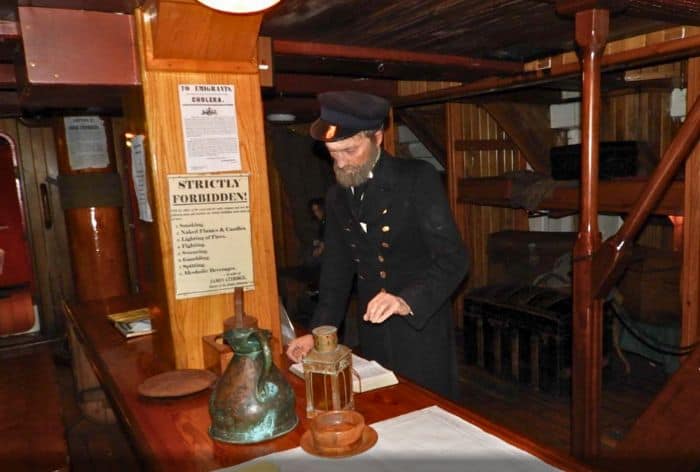
The Jeanie Johnston Tall Ship & Famine Experience
Additionally, the presence of a qualified doctor, Richard Blennerhassett, onboard provided essential medical care for the passengers.
This stands in stark contrast to the high mortality rates recorded on many other vessels known as “coffin ships” that carried Irish immigrants during the same period.
Trinity College and the Long Room
Next, let’s head to Trinity College and visit the famous Long Room.
Trinity College, founded in 1592, is Ireland’s oldest university and one of the most prestigious academic institutions in the world.
The college’s historic campus spans 47 acres and features the iconic Campanile and Parliament Square.
The Campanile is a bell tower built in 1853 from granite and is nearly 100 feet tall. The belfry is a cylindrical chamber with Corinthian columns around it, and at its base are four figures representing divinity, science, medicine, and law.
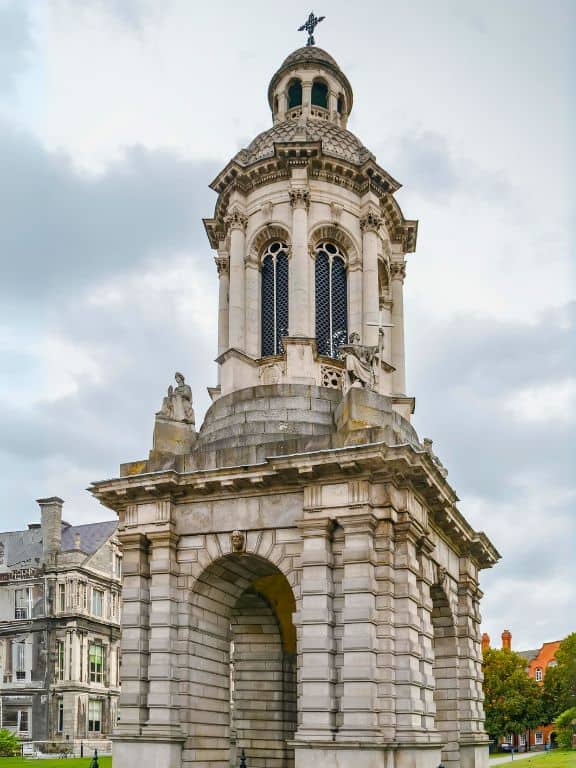
The Campanile at Trinity College / 2 Days in Dublin
Parliament Square is one of the four main squares that make up Trinity College’s Dublin campus. The square is surrounded by 18th-century buildings that create a court-like setting. The main entrance to Parliament Square is the Front Arch, designed by Theodore Jacobsen.
One of Trinity College’s most famous attractions is the Long Room, which is the main chamber of the Old Library.

Spectacular Long Room at Trinity College
Constructed between 1712 and 1732, the Long Room houses over 200,000 of the library’s oldest books and manuscripts, making it one of the most impressive libraries in Europe. Its grandeur is accentuated by the magnificent barrel-vaulted ceiling and rows of towering bookshelves, creating an atmosphere of timeless elegance.
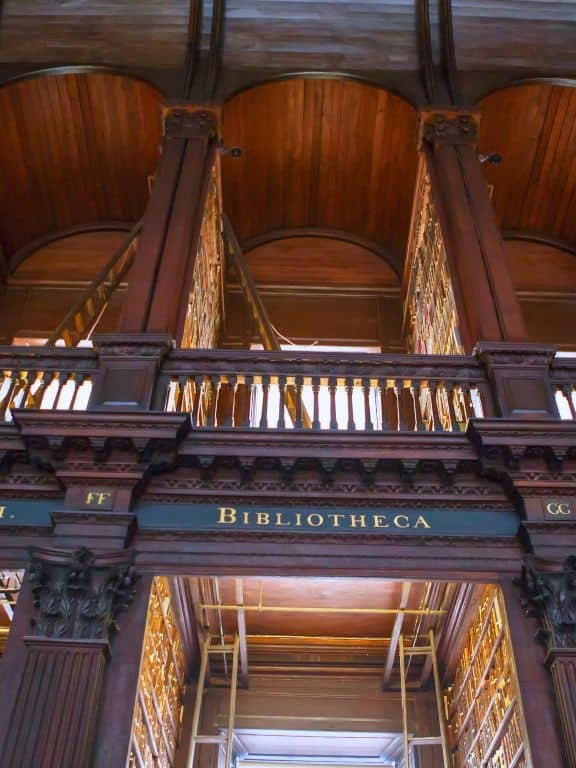
Long Room at Trinity College
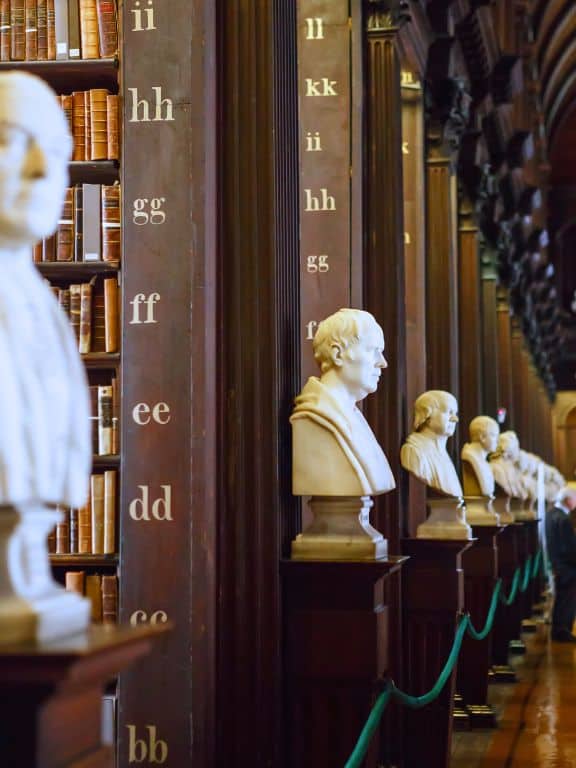
Long Room at Trinity College
Among the Long Room’s most notable treasures is the Book of Kells, a lavishly illuminated manuscript dating back to the 9th century.
Displayed in a specially designed case, this ancient artifact is a masterpiece of medieval artistry and is considered one of Ireland’s greatest national treasures.
I highly recommend the Fast-Track Book of Kells Ticket & Dublin Castle Tour. Skip the lines at Trinity College’s Old Library to witness the stunning Book of Kells. Then, wander through the captivating grounds of Dublin Castle. With the ticket including entrance to the Book of Kells, it’s the perfect way to explore Dublin’s rich heritage hassle-free.
The National Gallery of Ireland
Your next stop is the National Gallery of Ireland
The National Gallery of Ireland is a renowned art museum boasting over 16,000 works of art that span 1,300 years of Western European history.
Its diverse collection includes masterpieces by major Western European artists such as Rembrandt, Goya, Claude Monet, and Pablo Picasso, alongside prominent holdings from celebrated Irish artists like Daniel Maclise, John Lavery, and Jack B. Yeats.
Founded in 1854 and opened to the public in 1864, the gallery offers free admission. It will welcome you to explore its crimson and sapphire-hued walls adorned with an impressive array of artworks.
The collection is particularly acclaimed for its Italian Baroque and Dutch masters paintings.
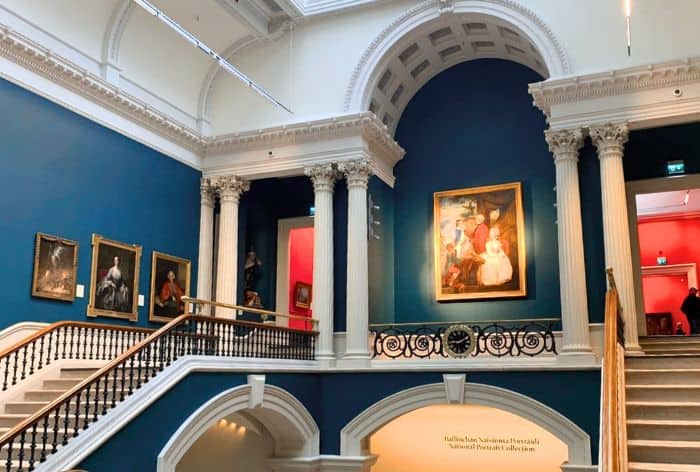
The National Gallery of Ireland / 2 Days in Dublin
GOOD TO KNOW: The National Gallery of Ireland features two entrances, one on Merrion Square and another on Clare Street. In addition to its permanent collection, the gallery hosts a variety of educational programs including tours, workshops, and lectures throughout the year.
If you can splurge, then I recommend The National Gallery of Ireland Dublin Private Tour. I love art museums and having a knowledgeable guide by your side is priceless.
The Little Museum of Dublin
Let’s continue to the next destination which is the Little Museum of Dublin. And, I have to admit, that it is one of my favorites in Dublin!
The Little Museum of Dublin is a cherished gift to the city from its residents, showcasing the vibrant history of Dublin throughout the 20th century. Its permanent collection consists of over 5,000 artifacts donated by Dubliners.
Among the museum’s notable exhibits are the personal collection of Alfie Byrne, Dublin’s beloved Lord Mayor, and the U2: Made in Dublin exhibition, which chronicles the iconic band’s journey over 40 years.
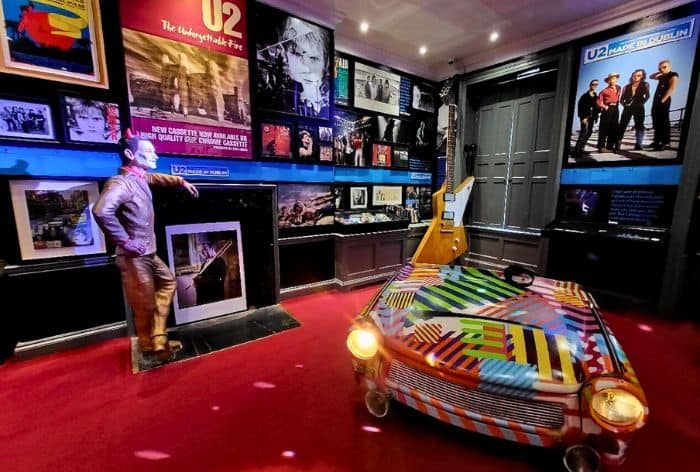
The Little Museum of Dublin
Stephen's Green Shopping Centre
Next on the 2-day Dublin itinerary is Stephen’s Green Shopping Centre. It is one of Dublin’s most prominent retail destinations, located just at the south end of Grafton Street.
One of the standout features of Stephen’s Green Shopping Centre is its striking architecture, characterized by ornate white ironwork and glass panels.
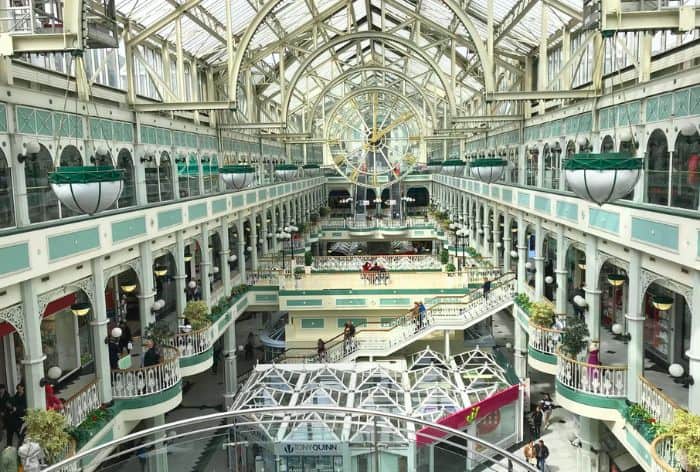
Stephen’s Green Shopping Centre
Locally known as “The Wedding Cake” due to its distinctive appearance, the shopping center is adorned with notable landmarks such as the Fusiliers’ Arch, sculptures representing the Three Fates, the WB Yeats Memorial Garden, a bust of James Joyce, and a memorial to the Fenian leader Jeremiah O’Donovan Rossa.
Additionally, the shopping center houses the largest indoor clock in Europe, adding to its unique character.
The Molly Malone Statue
The Molly Malone Statue is a prominent landmark depicting a young woman pushing a cart loaded with fish.
Erected in 1988, the statue stands at the intersection of Suffolk Street and Nassau Street, near Grafton Street.
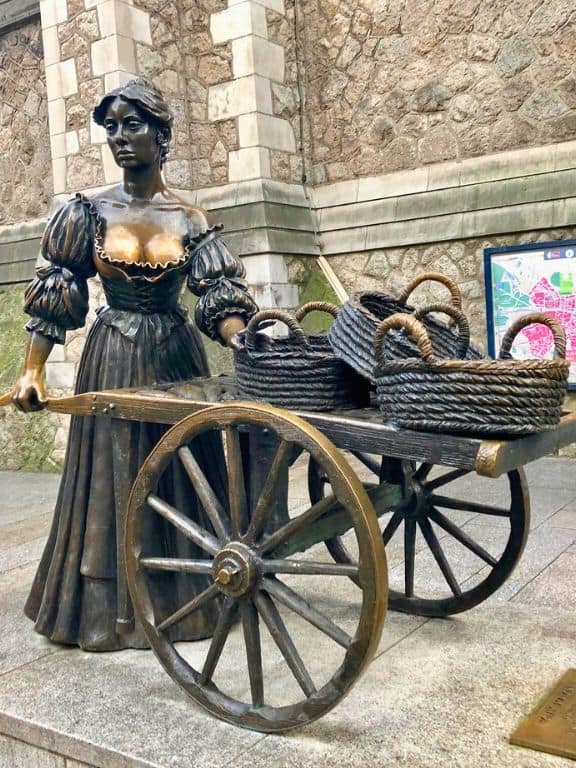
Molly Malone Statue in Dublin
The statue is based on the famous Irish folk song “Molly Malone” (also known as “Cockles and Mussels”), which tells the story of a fictional fishmonger named Molly Malone who plied her trade on the streets of Dublin. The song has become an emblem of Dublin’s cultural heritage and is often sung at festivals and events throughout the city.
It is customary for visitors to touch the statue’s breasts, which have become shiny from years of handling, as a gesture believed to bring good luck or fertility.
The Ha'penny Bridge
Next, head to the Ha’penny Bridge, officially known as the Liffey Bridge. It is a historic pedestrian bridge spanning the River Liffey.
Built in 1816 by William Walsh to replace his ferry, which used to cross the Liffey at Lower Ormond Quay, the bridge has since become one of the symbols of the city. Walsh was given an ultimatum to either refurbish the ferries or build a bridge, leading to the creation of this iconic structure.
Originally named the Wellington Bridge after the Duke of Wellington, who was born in Dublin, its name was changed to Liffey Bridge in 1922 after the Irish War of Independence. However, it is more commonly known as the Ha’penny Bridge, owing to the one halfpenny toll that was charged for crossing it.
The Ha’penny Bridge features a single arch and three lamps in the shape of lanterns on top of the arches, which are lit up at night. Its distinctive arched shape and decorative details have made it one of Dublin’s most photographed structures, attracting an estimated 30,000 pedestrians who cross the bridge every day.
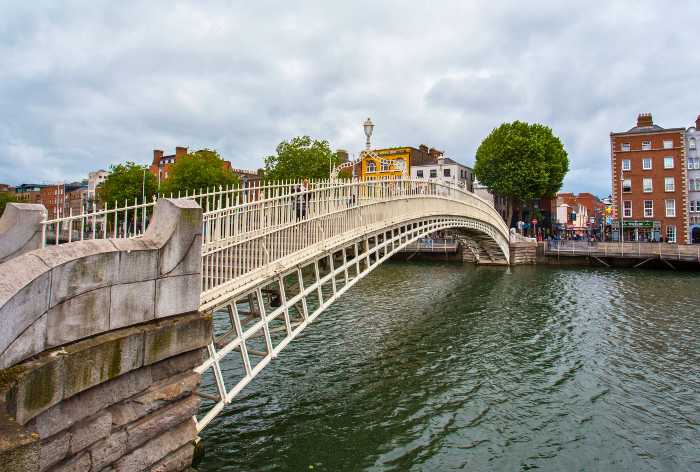
The Ha’penny Bridge in Dublin
Temple Bar District
The Temple Bar District is a cultural and entertainment area located in the heart of Dublin. It is known for its vibrant atmosphere, with numerous pubs, restaurants, galleries, and street performers.
The area’s name derives from Sir William Temple, who owned the land in the 17th century, and the Temple family, who built a house and gardens there.
Despite its reputation as a nightlife hotspot, the Temple Bar District also has a rich cultural heritage. It is home to several historic landmarks, including the Temple Bar Music Centre and the Irish Film Institute. Additionally, the area hosts various cultural festivals and events throughout the year, such as the Temple Bar TradFest and the Temple Bar Book Market.
If you’re looking to enjoy a pint of Guinness in a traditional Irish pub, then here are the most popular spots:
- The Temple Bar: This iconic pub is a must-visit for its lively atmosphere and traditional Irish music sessions.
- The Porterhouse: Known for its extensive selection of craft beers and live music.
- The Auld Dubliner: This cozy pub is popular for its warm hospitality, hearty food, and live music sessions.
- The Brazen Head: Established in 1198, this historic pub claims to be Ireland’s oldest pub.
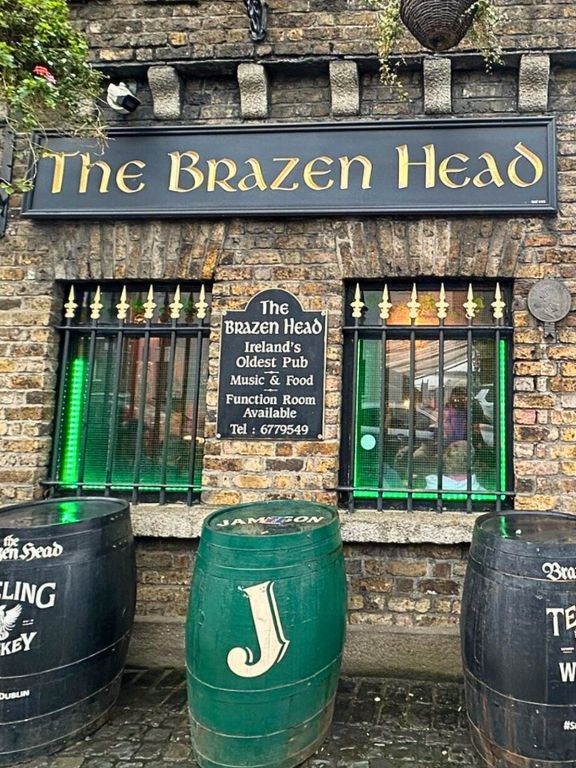
The Brazen Head in the Temple Bar District in Dublin
One tour that you might want to check out is: Dublin: Generation Pub Crawl. You get to visit some cool pubs, enjoy complimentary Guinness and shots, and benefit from exclusive drink discounts. This tour is a great way to explore Dublin’s pub scene and enjoy a fun night out.
After a day filled with Dublin’s delights, the Temple Bar District marks the perfect end to your adventures. Now, it’s time to retreat to your hotel for some well-deserved rest. Tomorrow promises another thrilling day of uncovering Dublin’s treasures.
DAY 2
- Dublin Castle
- Christ Church Cathedral
- Dublinia
- Kilmainham Goal
- Guinness Storehouse
Dublin Castle
Start your second day in Dublin with a tour of the Dublin Castle.
Dublin Castle was constructed in the 13th century atop a former Viking settlement. Initially serving as a military fortress, the castle evolved over the years to fulfill various roles, including as a prison, treasury, and court of law.
From 1204 until 1922, it stood as the seat of English and later British rule in Ireland. In 1922, Dublin Castle was handed over to the new Irish government and transformed into a government complex.
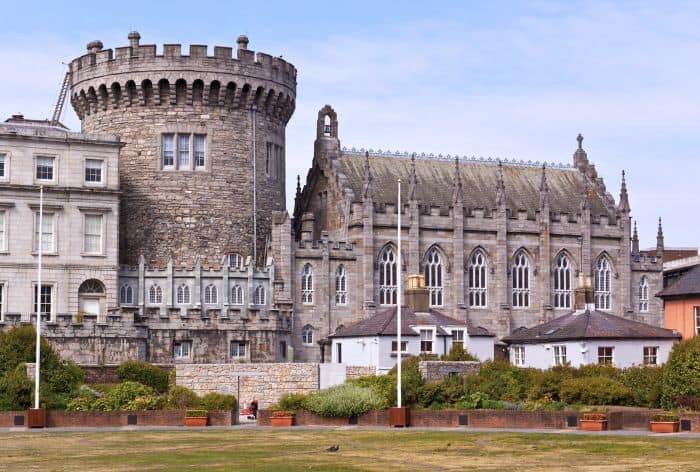
Dublin Castle and the Historic Record Tower
Dublin Castle has also left its mark on popular culture, featuring prominently in films, TV series, and music videos, including the acclaimed series “The Tudors.”
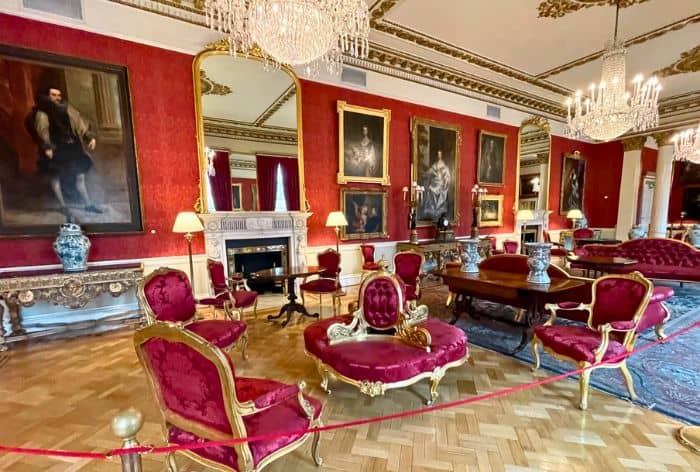
Dublin Castle Tour of the Interior Apartments
Among its historic structures, the Record Tower stands as a reminder of the castle’s enduring resilience, being the sole building to survive the fires and warfare that plagued the site over the centuries.
Christ Church Cathedral
Next head to Christ Church Cathedral located right by the Dublin Castle.
Christ Chruch Cathedral dates back to its founding in 1030 and it stands as one of Ireland’s oldest buildings. It was established by the first bishop of Dublin, Dúnán, and the Norse king of Dublin, Sitriuc.
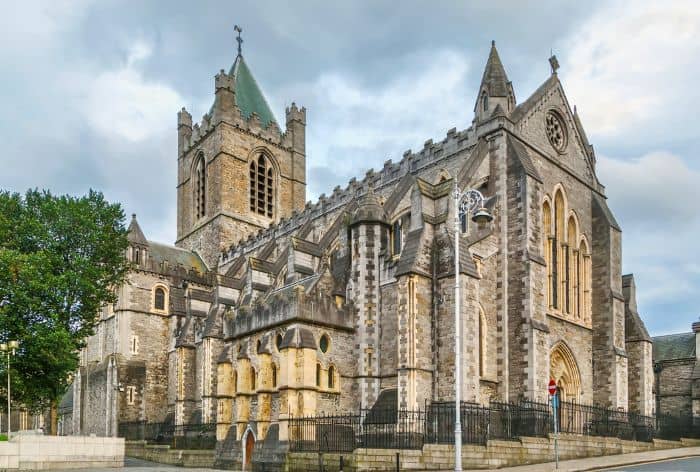
Christ Church Cathedral in Dublin / 2 Days in Dublin
Rebuilt in stone in the late 12th century by Strongbow, the Norman potentate, the cathedral underwent further enlargement in the early 13th century.
Over its nearly 1,000-year history, Christ Church Cathedral has been a revered place of pilgrimage.
Christ Church Cathedral offers self-guided tours that go over the cathedral’s past.
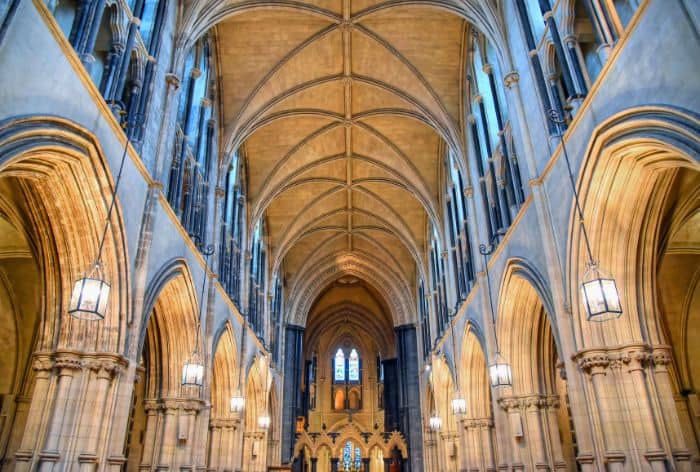
Christ Church Cathedral in Dublin / 2 Days in Dublin
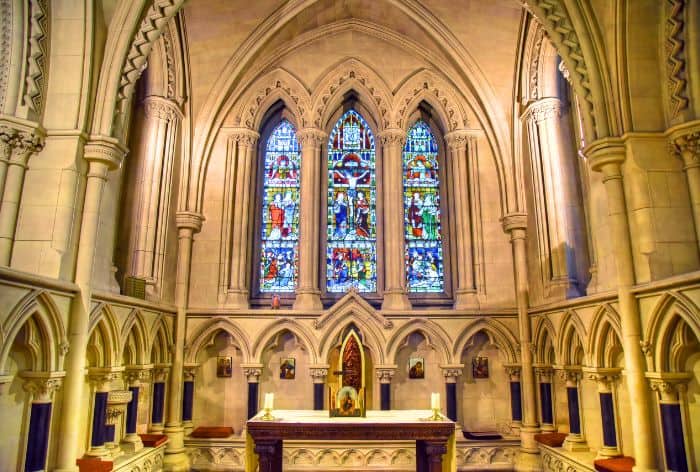
Christ Church Cathedral in Dublin / 2 Days in Dublin
Dublinia
Next on your exploration of Dublin is Dublinia. It is an interactive museum dedicated to showcasing the history of the city.
One of the main attractions at Dublinia is its Viking Dublin Exhibition, which delves into the Viking Age in Dublin from the 9th to the 11th centuries.
You will be able to explore Viking settlements, learn about trade and cultural exchanges, and discover the impact of Viking rule on the city.
Additionally, the museum’s Medieval Dublin Exhibition provides insights into life during the Middle Ages, covering topics such as trade, religion, and social structures.
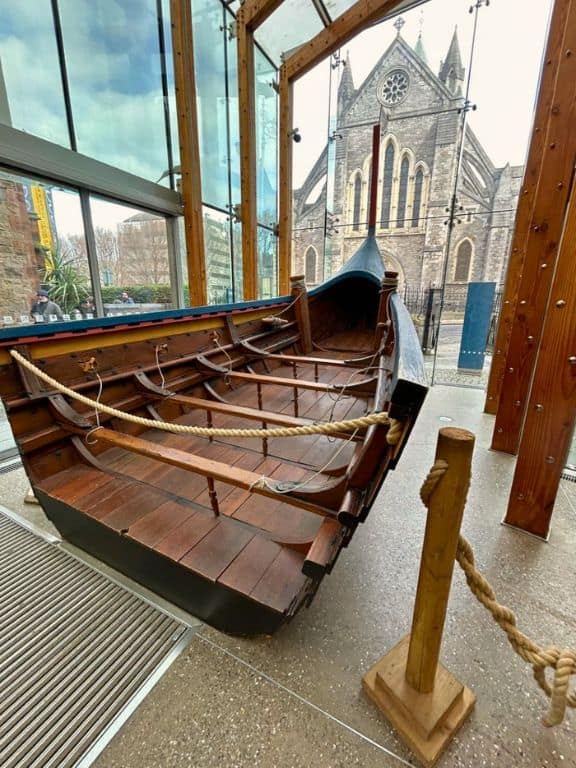
Dublinia / 2 Days in Dublin
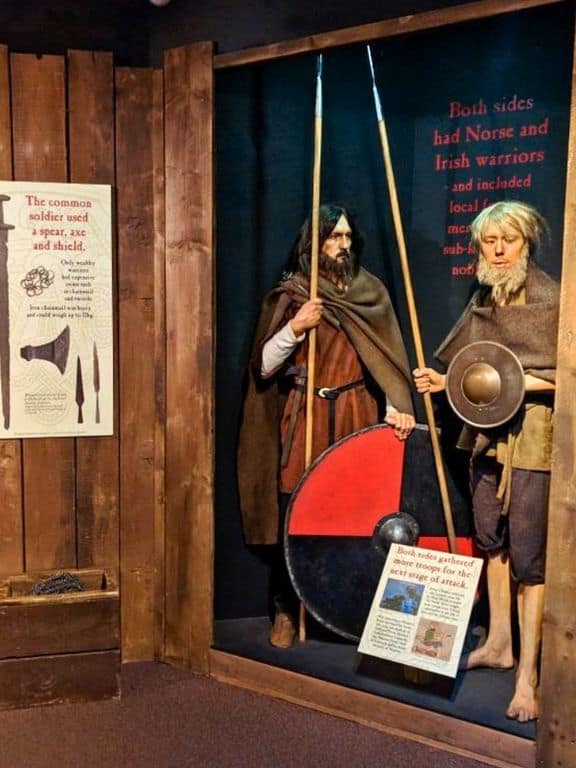
Dublinia / 2 Days in Dublin
Kilmainham Goal
Ahead of you is about a 30-minute walk from Dublinia to the next destination of the day, Kilmainham Goal.
Kilmainham Gaol was established in 1796. Throughout its operation, it housed a diverse array of prisoners, including political dissidents, rebels, and common criminals.
During Ireland’s struggle for independence, Kilmainham Gaol became a symbol of British oppression, as it held prominent figures such as Robert Emmet, Anne Devlin, Charles Stewart Parnell, Countess Markievicz, and the leaders of the 1916 Easter Rising.
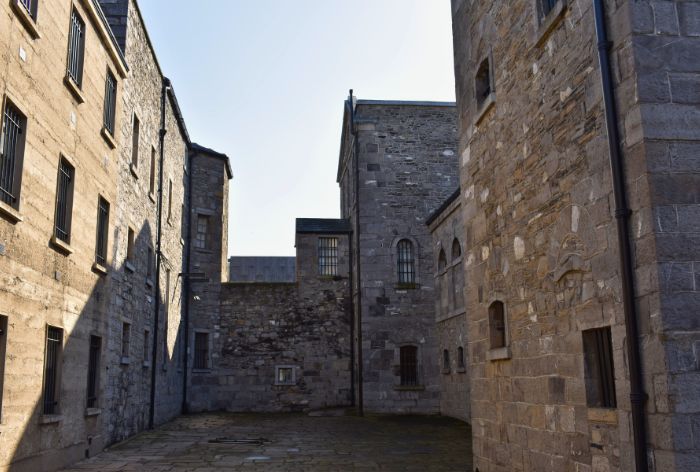
Kilmainham Goal
The gaol ceased operations in 1924 but was preserved as a national monument in the 1960s.
Today, Kilmainham Gaol serves as a museum and it will offer you a glimpse into Ireland’s tumultuous past.
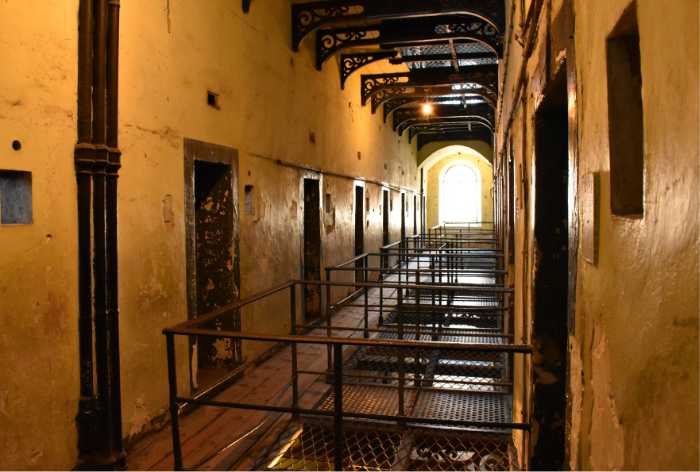
Kilmainham Goal
Additionally, Kilmainham Gaol has attracted attention from the entertainment industry, with its atmospheric surroundings used as a filming location for movies like “The Italian Job” and music videos by U2.
Guinness Storehouse
The Guinness Storehouse is the final stop on our itinerary. It stands as a testament to the rich heritage and brewing tradition of Guinness, Ireland’s most famous beer.
The storehouse spans seven floors and offers tours that go over the history, ingredients, and brewing process of Guinness.
Additionally, you can enjoy a variety of experiences, including the Guinness Connoisseur Experience, where they can learn about the art of tasting Guinness like a pro, and the Gravity Bar, which offers stunning panoramic views of Dublin while enjoying a complimentary pint of Guinness.
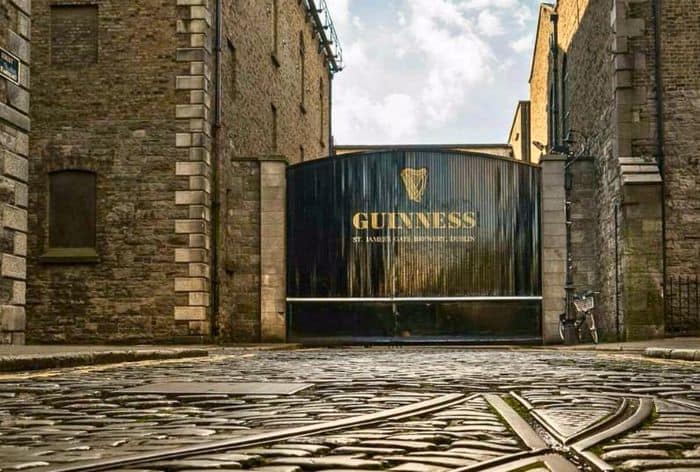
Guinness Storehouse
Final Intrepid Scout's Tips for 2 Days in Dublin
- Plan Ahead: Consider purchasing tickets online for popular attractions to skip the lines and make the most of your two days.
Check out my post: 14 Tips for First Visit to Dublin to Help You Explore Ireland’s Capital
- Explore on Foot: Dublin’s city center is compact and easily navigable on foot, making it ideal for exploring.
- Experience the Pub Culture: No visit to Dublin is complete without experiencing its legendary pub culture. Spend your evenings sampling traditional Irish pubs, and enjoying live music sessions.
- Try Local Cuisine: Be sure to sample some Irish specialties during your stay. Don’t miss trying dishes like Irish stew, fish and chips, and soda bread.
- Weather Preparedness: Dublin’s weather can be unpredictable, so pack accordingly with layers and waterproof clothing. Check the weather forecast before heading out and be prepared for rain or shine.
- Enjoy the Craic: Above all, relax, enjoy the craic (Irish for fun and good times), and soak up the lively atmosphere of Dublin.
More Information About Ireland:
20 Must-See Sights and Attractions in Ireland (Your Essential Guide to the Emerald Isle)
14 Delicious Traditional Irish Foods You Must Try During Your Visit to Ireland
Perfect 10-Day Ireland Road Trip Itinerary (Detailed Map+Tips for Planning)
9 Amazing Things to Do in Killarney National Park (Maps+Tips)
22 Best Stops on the Ring of Kerry (Map+Top Attractions at Each Stop)
Perfect 1-Day Ring of Kerry Drive Itinerary
16 Best Stops on the Dingle Peninsula Drive (map+detailed tips)
You Might Also Like:
82 Quotes About Ireland And the Irish Spirit Celebrating the Emerald Isle
102 Beautiful Irish Proverbs and Sayings Offering Timeless Lessons
92 Irish Blessings And Wishes Embracing Joy on St. Patrick’s Day
Did You Find 2 Days in Dublin Helpful? Pin it!
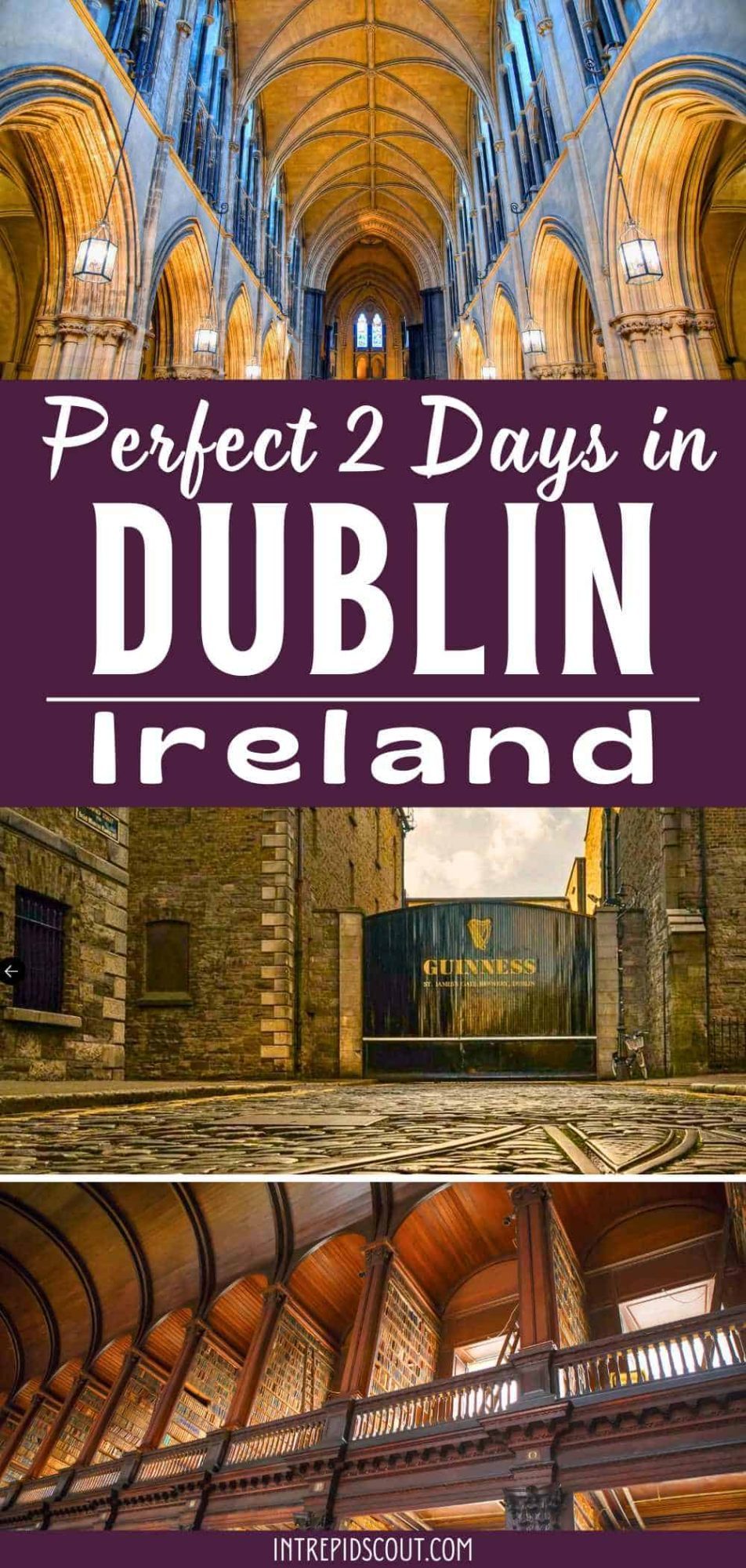

Now, It Is Your Turn, I Would Like to Hear Back from You!
Are you planning your trip to Ireland?
Please let me know! Drop me a quick comment right below!
Click on any of the images below to get inspired and to help you with the planning process for your trip to Ireland!
